Financial Management Accounting Exam Solution, LD Training, 2020/21
VerifiedAdded on 2022/12/09
|8
|1482
|401
Homework Assignment
AI Summary
This document presents a comprehensive solution to a financial management accounting exam, addressing three case study questions. Question 1 analyzes Happyday Caterers Ltd., calculating gross and net profit, providing ratio analysis, and offering strategic recommendations to address declining profits and cash flow issues. Question 2 focuses on break-even point calculations, setting profitable sales targets, and evaluating the switch to activity-based costing. Question 3 involves calculating variances (sales, direct material, and direct labor), identifying their causes and consequences, and suggesting strategies for elimination or correlation. The solution also explores the advantages and disadvantages of switching from incremental-based budgeting to zero-based budgeting. The document includes detailed calculations, explanations, and references to support the analysis.
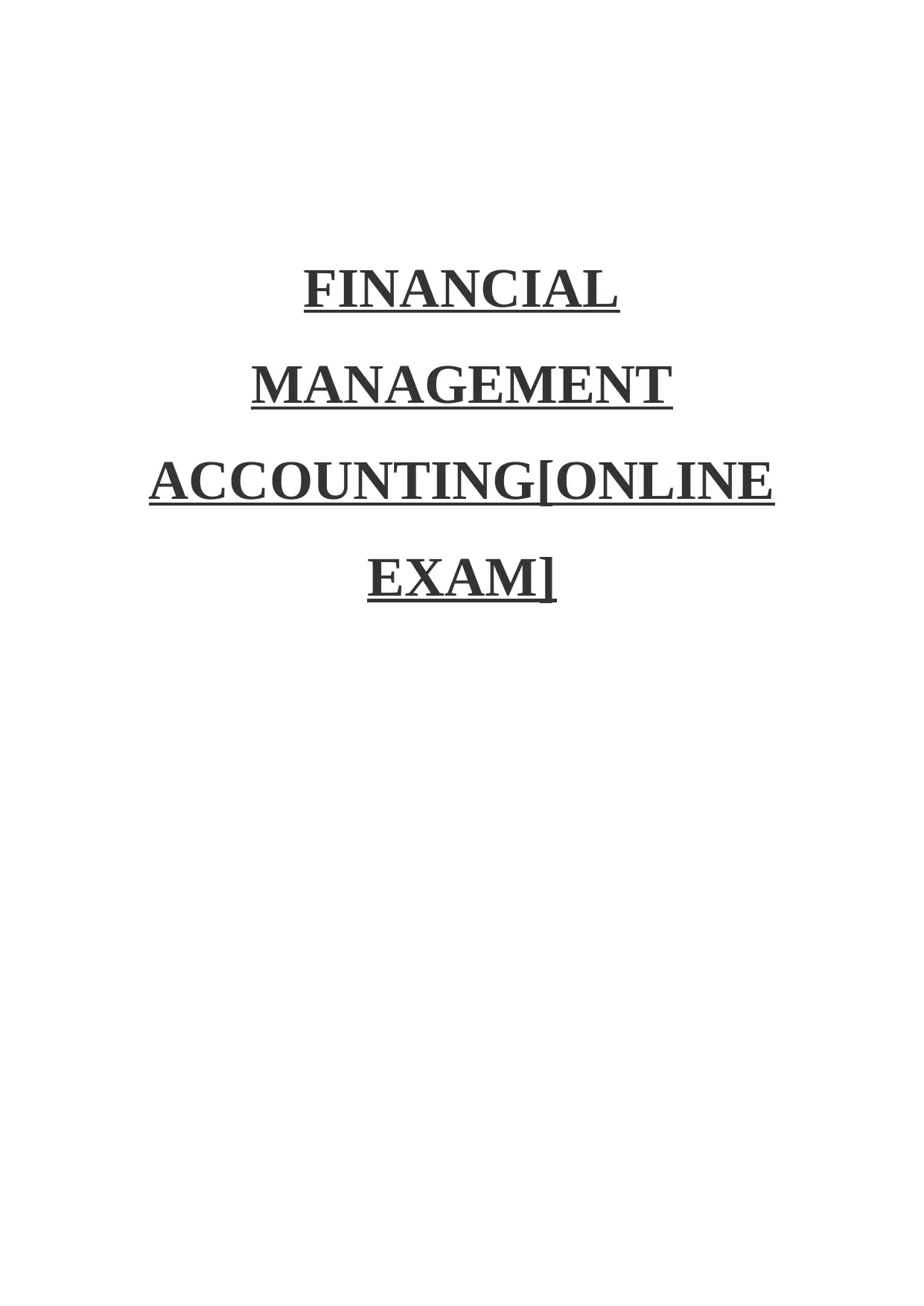
FINANCIAL
MANAGEMENT
ACCOUNTING[ONLINE
EXAM]
MANAGEMENT
ACCOUNTING[ONLINE
EXAM]
Paraphrase This Document
Need a fresh take? Get an instant paraphrase of this document with our AI Paraphraser
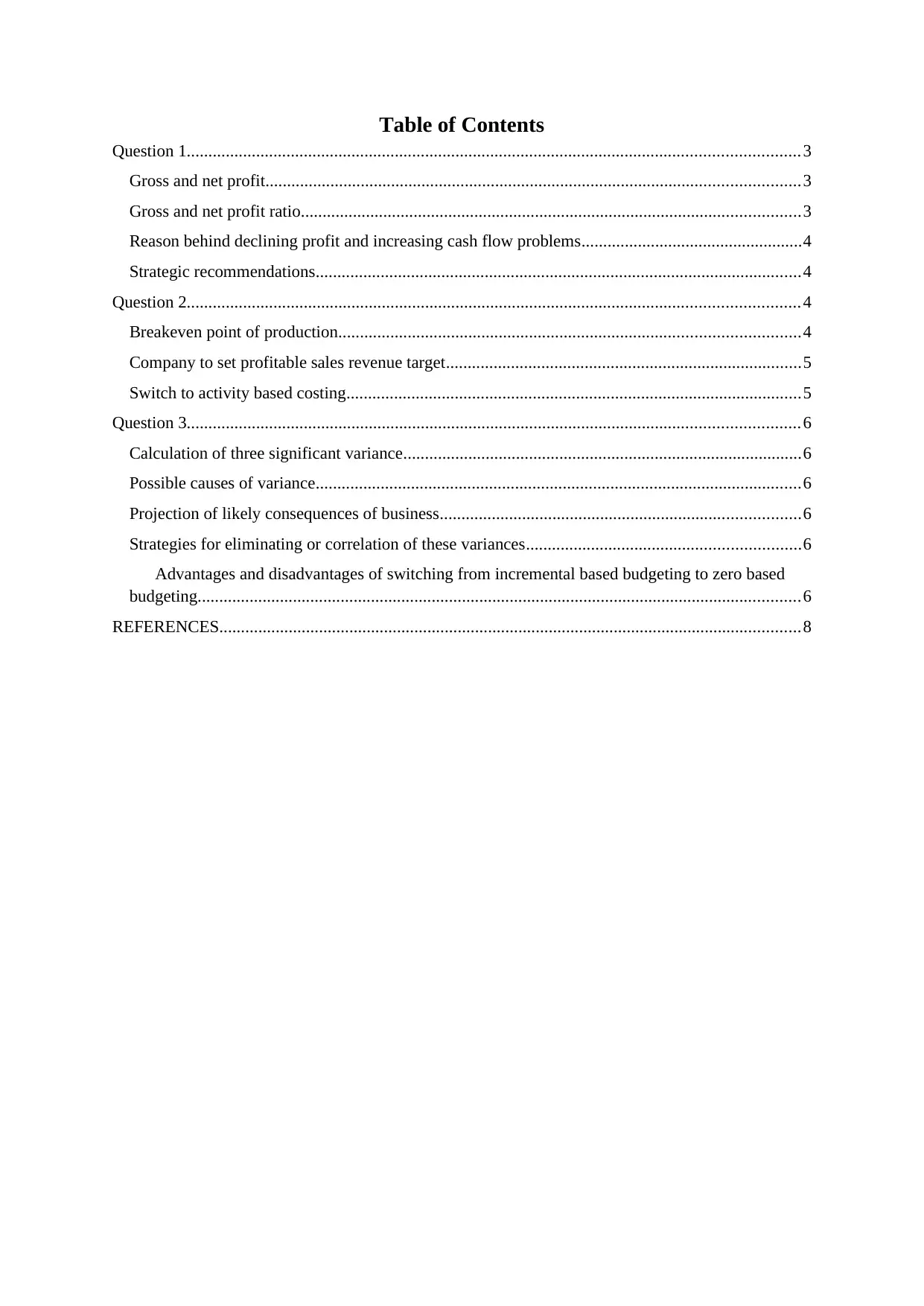
Table of Contents
Question 1.............................................................................................................................................3
Gross and net profit...........................................................................................................................3
Gross and net profit ratio...................................................................................................................3
Reason behind declining profit and increasing cash flow problems...................................................4
Strategic recommendations................................................................................................................4
Question 2.............................................................................................................................................4
Breakeven point of production..........................................................................................................4
Company to set profitable sales revenue target..................................................................................5
Switch to activity based costing.........................................................................................................5
Question 3.............................................................................................................................................6
Calculation of three significant variance............................................................................................6
Possible causes of variance................................................................................................................6
Projection of likely consequences of business...................................................................................6
Strategies for eliminating or correlation of these variances...............................................................6
Advantages and disadvantages of switching from incremental based budgeting to zero based
budgeting...........................................................................................................................................6
REFERENCES......................................................................................................................................8
Question 1.............................................................................................................................................3
Gross and net profit...........................................................................................................................3
Gross and net profit ratio...................................................................................................................3
Reason behind declining profit and increasing cash flow problems...................................................4
Strategic recommendations................................................................................................................4
Question 2.............................................................................................................................................4
Breakeven point of production..........................................................................................................4
Company to set profitable sales revenue target..................................................................................5
Switch to activity based costing.........................................................................................................5
Question 3.............................................................................................................................................6
Calculation of three significant variance............................................................................................6
Possible causes of variance................................................................................................................6
Projection of likely consequences of business...................................................................................6
Strategies for eliminating or correlation of these variances...............................................................6
Advantages and disadvantages of switching from incremental based budgeting to zero based
budgeting...........................................................................................................................................6
REFERENCES......................................................................................................................................8
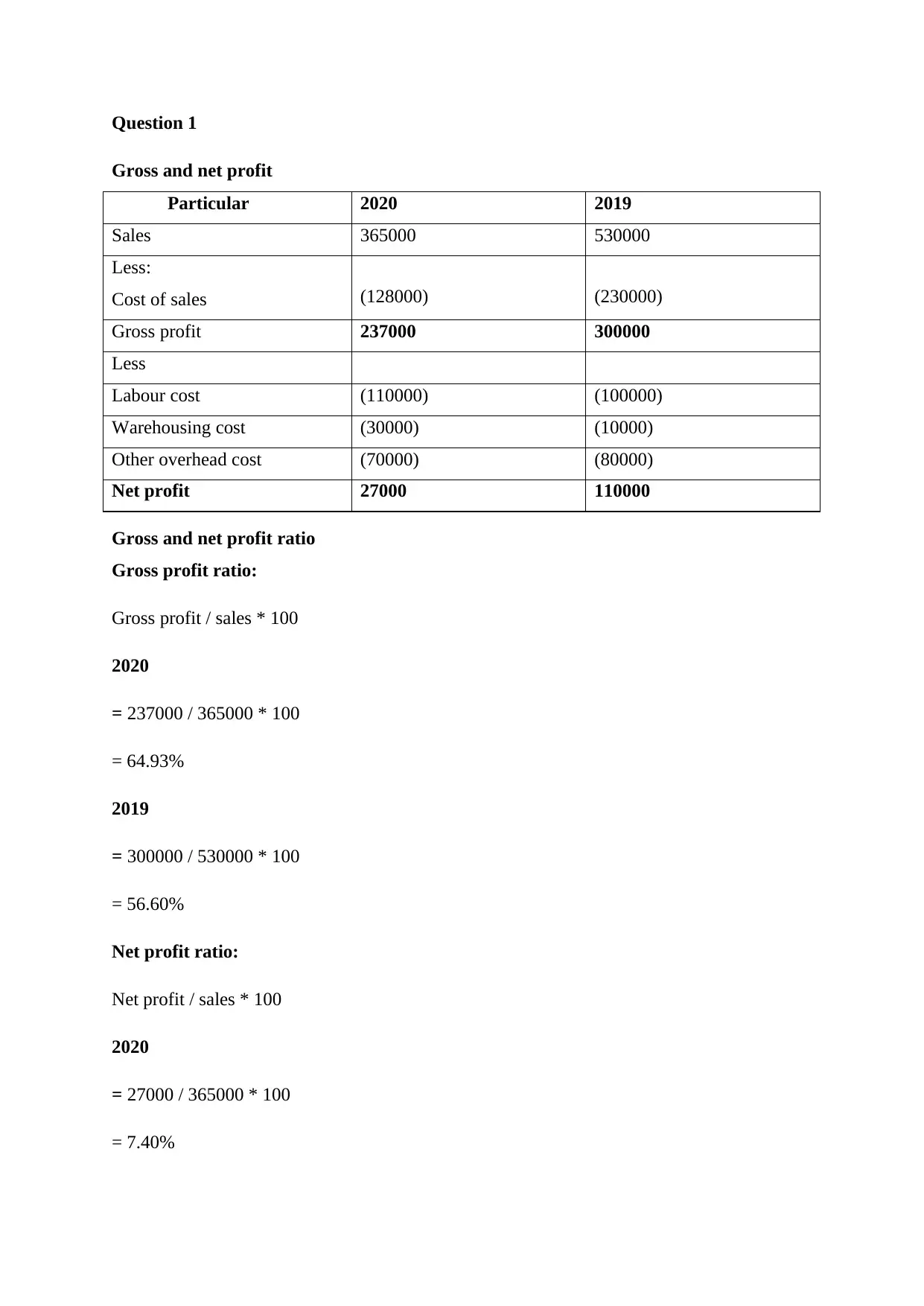
Question 1
Gross and net profit
Particular 2020 2019
Sales 365000 530000
Less:
Cost of sales (128000) (230000)
Gross profit 237000 300000
Less
Labour cost (110000) (100000)
Warehousing cost (30000) (10000)
Other overhead cost (70000) (80000)
Net profit 27000 110000
Gross and net profit ratio
Gross profit ratio:
Gross profit / sales * 100
2020
= 237000 / 365000 * 100
= 64.93%
2019
= 300000 / 530000 * 100
= 56.60%
Net profit ratio:
Net profit / sales * 100
2020
= 27000 / 365000 * 100
= 7.40%
Gross and net profit
Particular 2020 2019
Sales 365000 530000
Less:
Cost of sales (128000) (230000)
Gross profit 237000 300000
Less
Labour cost (110000) (100000)
Warehousing cost (30000) (10000)
Other overhead cost (70000) (80000)
Net profit 27000 110000
Gross and net profit ratio
Gross profit ratio:
Gross profit / sales * 100
2020
= 237000 / 365000 * 100
= 64.93%
2019
= 300000 / 530000 * 100
= 56.60%
Net profit ratio:
Net profit / sales * 100
2020
= 27000 / 365000 * 100
= 7.40%
⊘ This is a preview!⊘
Do you want full access?
Subscribe today to unlock all pages.

Trusted by 1+ million students worldwide
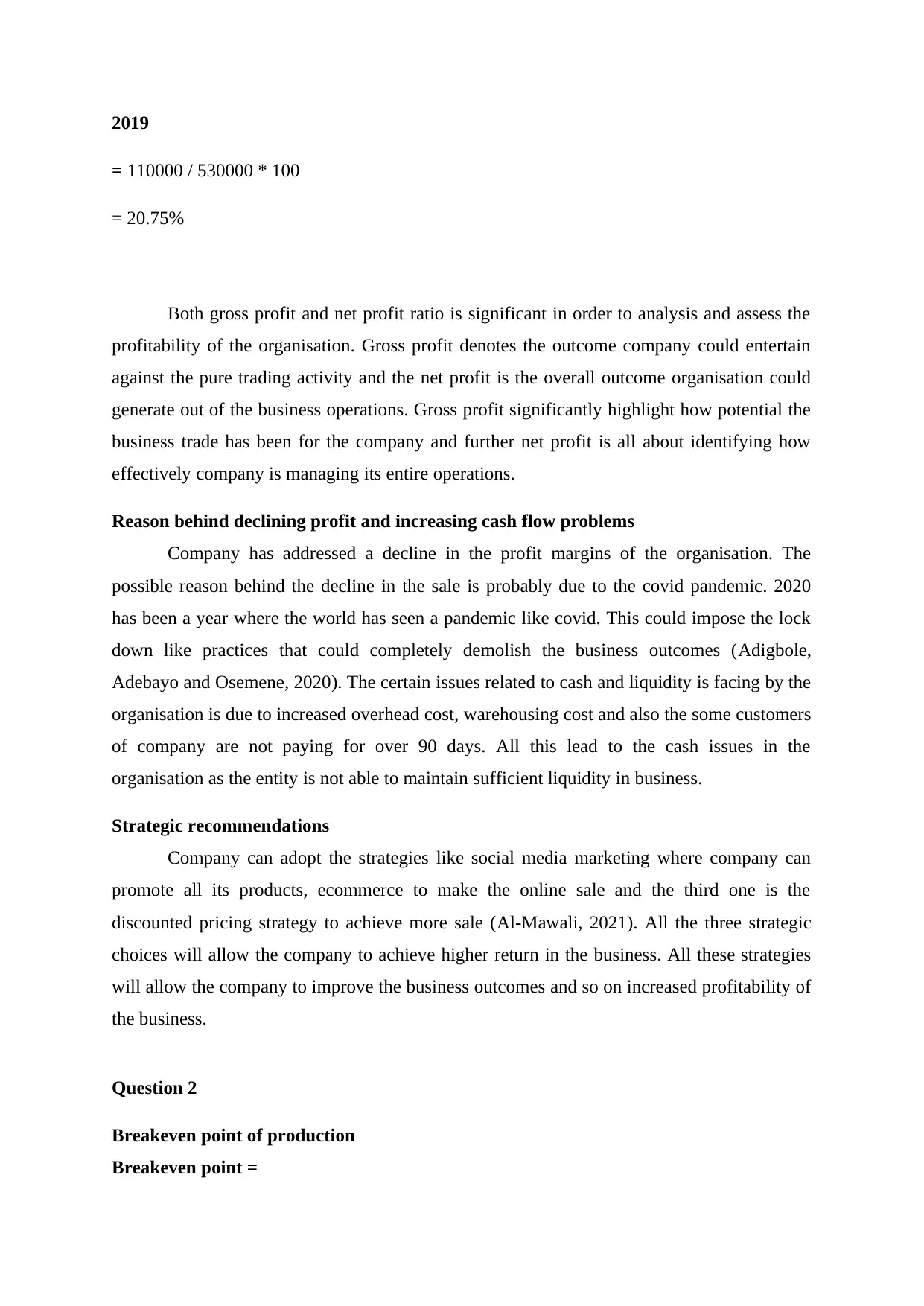
2019
= 110000 / 530000 * 100
= 20.75%
Both gross profit and net profit ratio is significant in order to analysis and assess the
profitability of the organisation. Gross profit denotes the outcome company could entertain
against the pure trading activity and the net profit is the overall outcome organisation could
generate out of the business operations. Gross profit significantly highlight how potential the
business trade has been for the company and further net profit is all about identifying how
effectively company is managing its entire operations.
Reason behind declining profit and increasing cash flow problems
Company has addressed a decline in the profit margins of the organisation. The
possible reason behind the decline in the sale is probably due to the covid pandemic. 2020
has been a year where the world has seen a pandemic like covid. This could impose the lock
down like practices that could completely demolish the business outcomes (Adigbole,
Adebayo and Osemene, 2020). The certain issues related to cash and liquidity is facing by the
organisation is due to increased overhead cost, warehousing cost and also the some customers
of company are not paying for over 90 days. All this lead to the cash issues in the
organisation as the entity is not able to maintain sufficient liquidity in business.
Strategic recommendations
Company can adopt the strategies like social media marketing where company can
promote all its products, ecommerce to make the online sale and the third one is the
discounted pricing strategy to achieve more sale (Al-Mawali, 2021). All the three strategic
choices will allow the company to achieve higher return in the business. All these strategies
will allow the company to improve the business outcomes and so on increased profitability of
the business.
Question 2
Breakeven point of production
Breakeven point =
= 110000 / 530000 * 100
= 20.75%
Both gross profit and net profit ratio is significant in order to analysis and assess the
profitability of the organisation. Gross profit denotes the outcome company could entertain
against the pure trading activity and the net profit is the overall outcome organisation could
generate out of the business operations. Gross profit significantly highlight how potential the
business trade has been for the company and further net profit is all about identifying how
effectively company is managing its entire operations.
Reason behind declining profit and increasing cash flow problems
Company has addressed a decline in the profit margins of the organisation. The
possible reason behind the decline in the sale is probably due to the covid pandemic. 2020
has been a year where the world has seen a pandemic like covid. This could impose the lock
down like practices that could completely demolish the business outcomes (Adigbole,
Adebayo and Osemene, 2020). The certain issues related to cash and liquidity is facing by the
organisation is due to increased overhead cost, warehousing cost and also the some customers
of company are not paying for over 90 days. All this lead to the cash issues in the
organisation as the entity is not able to maintain sufficient liquidity in business.
Strategic recommendations
Company can adopt the strategies like social media marketing where company can
promote all its products, ecommerce to make the online sale and the third one is the
discounted pricing strategy to achieve more sale (Al-Mawali, 2021). All the three strategic
choices will allow the company to achieve higher return in the business. All these strategies
will allow the company to improve the business outcomes and so on increased profitability of
the business.
Question 2
Breakeven point of production
Breakeven point =
Paraphrase This Document
Need a fresh take? Get an instant paraphrase of this document with our AI Paraphraser
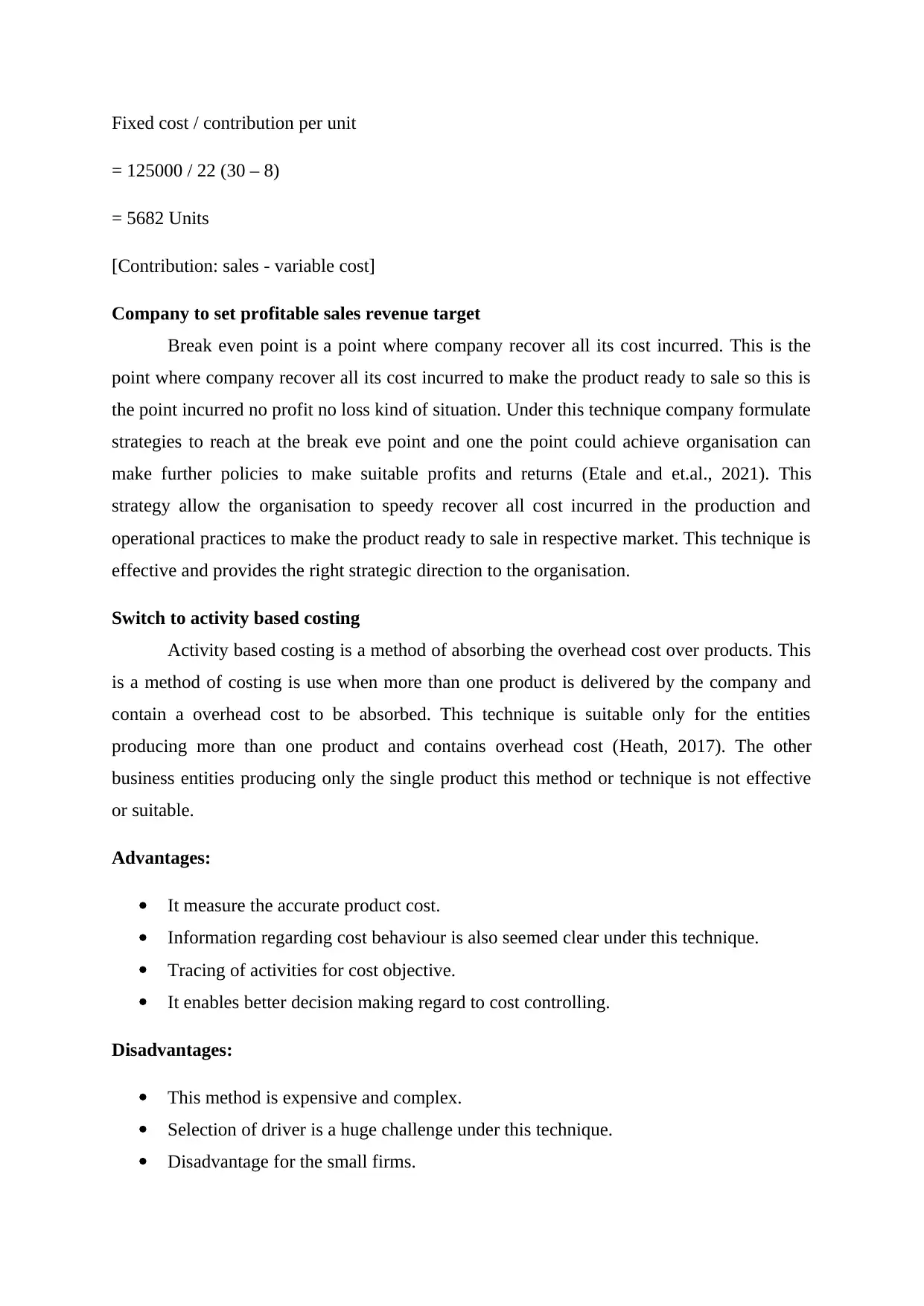
Fixed cost / contribution per unit
= 125000 / 22 (30 – 8)
= 5682 Units
[Contribution: sales - variable cost]
Company to set profitable sales revenue target
Break even point is a point where company recover all its cost incurred. This is the
point where company recover all its cost incurred to make the product ready to sale so this is
the point incurred no profit no loss kind of situation. Under this technique company formulate
strategies to reach at the break eve point and one the point could achieve organisation can
make further policies to make suitable profits and returns (Etale and et.al., 2021). This
strategy allow the organisation to speedy recover all cost incurred in the production and
operational practices to make the product ready to sale in respective market. This technique is
effective and provides the right strategic direction to the organisation.
Switch to activity based costing
Activity based costing is a method of absorbing the overhead cost over products. This
is a method of costing is use when more than one product is delivered by the company and
contain a overhead cost to be absorbed. This technique is suitable only for the entities
producing more than one product and contains overhead cost (Heath, 2017). The other
business entities producing only the single product this method or technique is not effective
or suitable.
Advantages:
It measure the accurate product cost.
Information regarding cost behaviour is also seemed clear under this technique.
Tracing of activities for cost objective.
It enables better decision making regard to cost controlling.
Disadvantages:
This method is expensive and complex.
Selection of driver is a huge challenge under this technique.
Disadvantage for the small firms.
= 125000 / 22 (30 – 8)
= 5682 Units
[Contribution: sales - variable cost]
Company to set profitable sales revenue target
Break even point is a point where company recover all its cost incurred. This is the
point where company recover all its cost incurred to make the product ready to sale so this is
the point incurred no profit no loss kind of situation. Under this technique company formulate
strategies to reach at the break eve point and one the point could achieve organisation can
make further policies to make suitable profits and returns (Etale and et.al., 2021). This
strategy allow the organisation to speedy recover all cost incurred in the production and
operational practices to make the product ready to sale in respective market. This technique is
effective and provides the right strategic direction to the organisation.
Switch to activity based costing
Activity based costing is a method of absorbing the overhead cost over products. This
is a method of costing is use when more than one product is delivered by the company and
contain a overhead cost to be absorbed. This technique is suitable only for the entities
producing more than one product and contains overhead cost (Heath, 2017). The other
business entities producing only the single product this method or technique is not effective
or suitable.
Advantages:
It measure the accurate product cost.
Information regarding cost behaviour is also seemed clear under this technique.
Tracing of activities for cost objective.
It enables better decision making regard to cost controlling.
Disadvantages:
This method is expensive and complex.
Selection of driver is a huge challenge under this technique.
Disadvantage for the small firms.
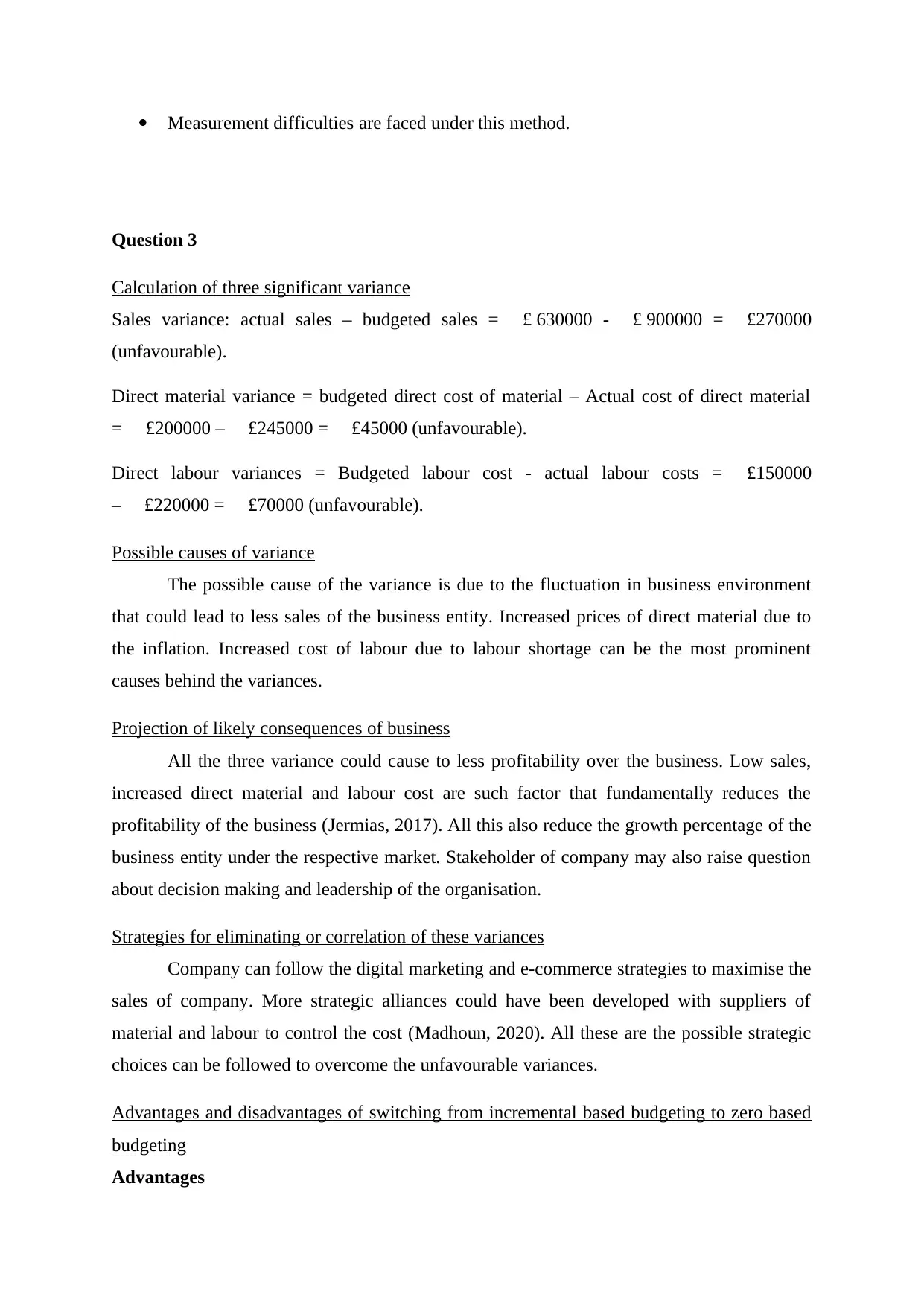
Measurement difficulties are faced under this method.
Question 3
Calculation of three significant variance
Sales variance: actual sales – budgeted sales = £ 630000 - £ 900000 = £270000
(unfavourable).
Direct material variance = budgeted direct cost of material – Actual cost of direct material
= £200000 – £245000 = £45000 (unfavourable).
Direct labour variances = Budgeted labour cost - actual labour costs = £150000
– £220000 = £70000 (unfavourable).
Possible causes of variance
The possible cause of the variance is due to the fluctuation in business environment
that could lead to less sales of the business entity. Increased prices of direct material due to
the inflation. Increased cost of labour due to labour shortage can be the most prominent
causes behind the variances.
Projection of likely consequences of business
All the three variance could cause to less profitability over the business. Low sales,
increased direct material and labour cost are such factor that fundamentally reduces the
profitability of the business (Jermias, 2017). All this also reduce the growth percentage of the
business entity under the respective market. Stakeholder of company may also raise question
about decision making and leadership of the organisation.
Strategies for eliminating or correlation of these variances
Company can follow the digital marketing and e-commerce strategies to maximise the
sales of company. More strategic alliances could have been developed with suppliers of
material and labour to control the cost (Madhoun, 2020). All these are the possible strategic
choices can be followed to overcome the unfavourable variances.
Advantages and disadvantages of switching from incremental based budgeting to zero based
budgeting
Advantages
Question 3
Calculation of three significant variance
Sales variance: actual sales – budgeted sales = £ 630000 - £ 900000 = £270000
(unfavourable).
Direct material variance = budgeted direct cost of material – Actual cost of direct material
= £200000 – £245000 = £45000 (unfavourable).
Direct labour variances = Budgeted labour cost - actual labour costs = £150000
– £220000 = £70000 (unfavourable).
Possible causes of variance
The possible cause of the variance is due to the fluctuation in business environment
that could lead to less sales of the business entity. Increased prices of direct material due to
the inflation. Increased cost of labour due to labour shortage can be the most prominent
causes behind the variances.
Projection of likely consequences of business
All the three variance could cause to less profitability over the business. Low sales,
increased direct material and labour cost are such factor that fundamentally reduces the
profitability of the business (Jermias, 2017). All this also reduce the growth percentage of the
business entity under the respective market. Stakeholder of company may also raise question
about decision making and leadership of the organisation.
Strategies for eliminating or correlation of these variances
Company can follow the digital marketing and e-commerce strategies to maximise the
sales of company. More strategic alliances could have been developed with suppliers of
material and labour to control the cost (Madhoun, 2020). All these are the possible strategic
choices can be followed to overcome the unfavourable variances.
Advantages and disadvantages of switching from incremental based budgeting to zero based
budgeting
Advantages
⊘ This is a preview!⊘
Do you want full access?
Subscribe today to unlock all pages.

Trusted by 1+ million students worldwide
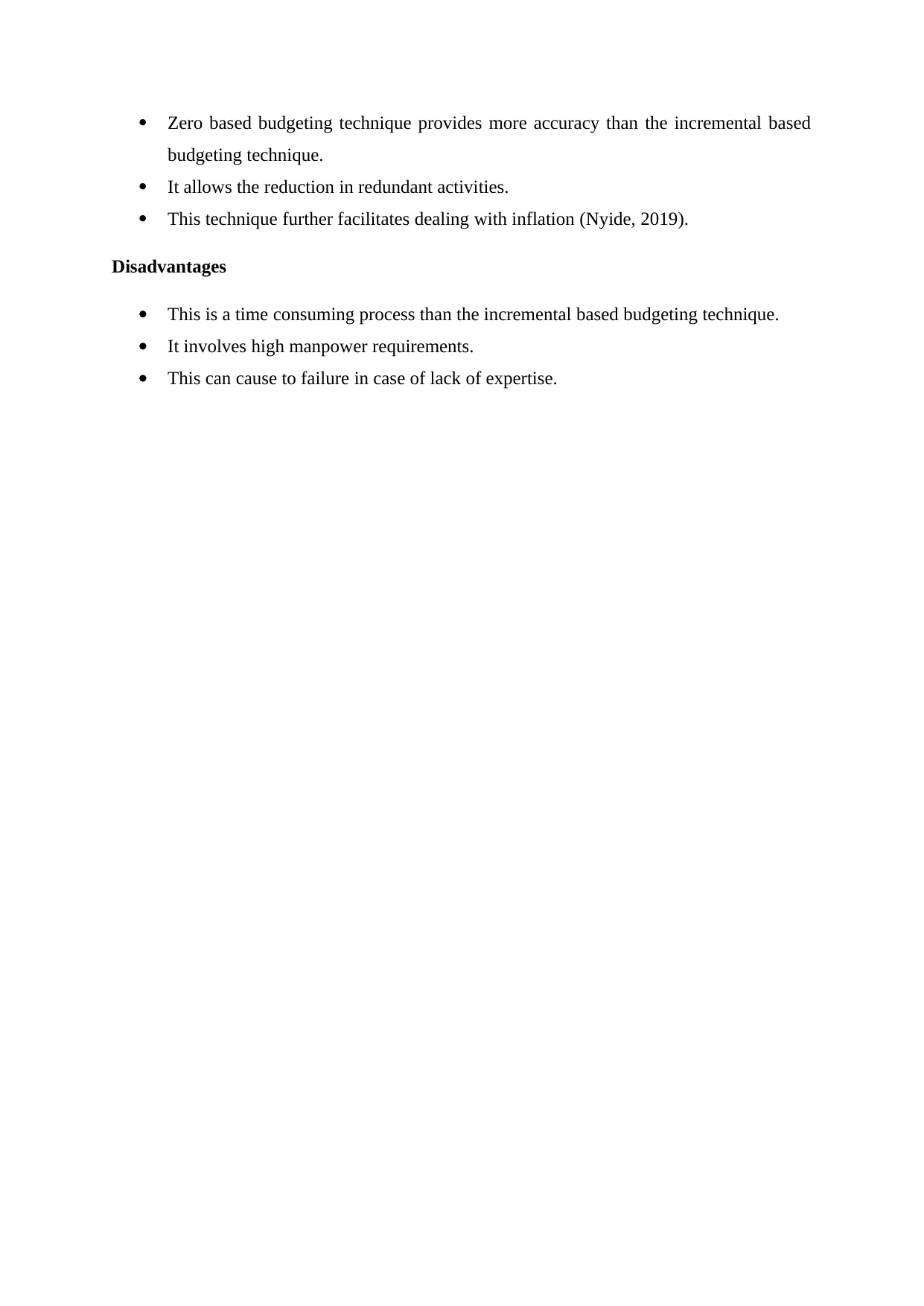
Zero based budgeting technique provides more accuracy than the incremental based
budgeting technique.
It allows the reduction in redundant activities.
This technique further facilitates dealing with inflation (Nyide, 2019).
Disadvantages
This is a time consuming process than the incremental based budgeting technique.
It involves high manpower requirements.
This can cause to failure in case of lack of expertise.
budgeting technique.
It allows the reduction in redundant activities.
This technique further facilitates dealing with inflation (Nyide, 2019).
Disadvantages
This is a time consuming process than the incremental based budgeting technique.
It involves high manpower requirements.
This can cause to failure in case of lack of expertise.
Paraphrase This Document
Need a fresh take? Get an instant paraphrase of this document with our AI Paraphraser
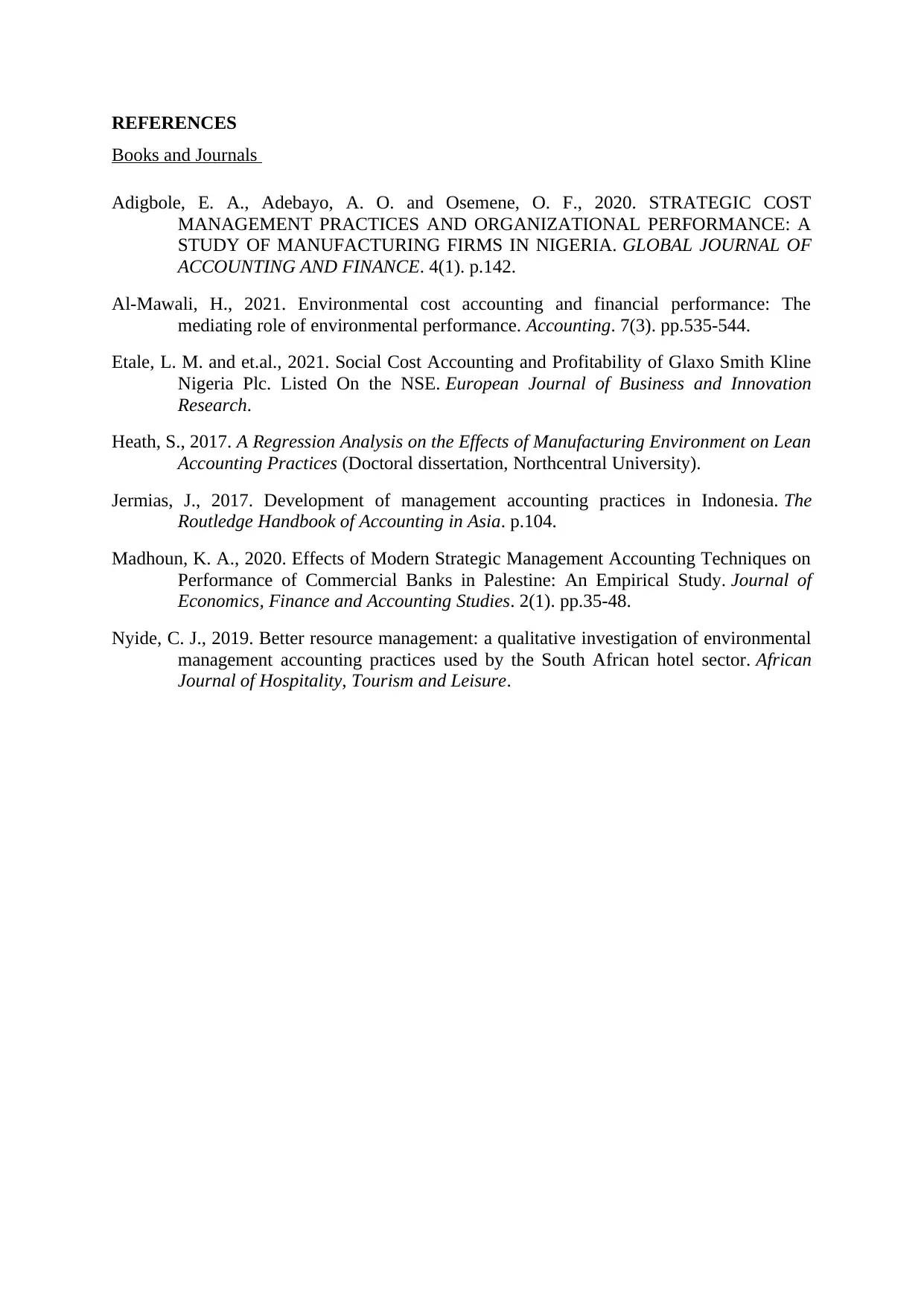
REFERENCES
Books and Journals
Adigbole, E. A., Adebayo, A. O. and Osemene, O. F., 2020. STRATEGIC COST
MANAGEMENT PRACTICES AND ORGANIZATIONAL PERFORMANCE: A
STUDY OF MANUFACTURING FIRMS IN NIGERIA. GLOBAL JOURNAL OF
ACCOUNTING AND FINANCE. 4(1). p.142.
Al-Mawali, H., 2021. Environmental cost accounting and financial performance: The
mediating role of environmental performance. Accounting. 7(3). pp.535-544.
Etale, L. M. and et.al., 2021. Social Cost Accounting and Profitability of Glaxo Smith Kline
Nigeria Plc. Listed On the NSE. European Journal of Business and Innovation
Research.
Heath, S., 2017. A Regression Analysis on the Effects of Manufacturing Environment on Lean
Accounting Practices (Doctoral dissertation, Northcentral University).
Jermias, J., 2017. Development of management accounting practices in Indonesia. The
Routledge Handbook of Accounting in Asia. p.104.
Madhoun, K. A., 2020. Effects of Modern Strategic Management Accounting Techniques on
Performance of Commercial Banks in Palestine: An Empirical Study. Journal of
Economics, Finance and Accounting Studies. 2(1). pp.35-48.
Nyide, C. J., 2019. Better resource management: a qualitative investigation of environmental
management accounting practices used by the South African hotel sector. African
Journal of Hospitality, Tourism and Leisure.
Books and Journals
Adigbole, E. A., Adebayo, A. O. and Osemene, O. F., 2020. STRATEGIC COST
MANAGEMENT PRACTICES AND ORGANIZATIONAL PERFORMANCE: A
STUDY OF MANUFACTURING FIRMS IN NIGERIA. GLOBAL JOURNAL OF
ACCOUNTING AND FINANCE. 4(1). p.142.
Al-Mawali, H., 2021. Environmental cost accounting and financial performance: The
mediating role of environmental performance. Accounting. 7(3). pp.535-544.
Etale, L. M. and et.al., 2021. Social Cost Accounting and Profitability of Glaxo Smith Kline
Nigeria Plc. Listed On the NSE. European Journal of Business and Innovation
Research.
Heath, S., 2017. A Regression Analysis on the Effects of Manufacturing Environment on Lean
Accounting Practices (Doctoral dissertation, Northcentral University).
Jermias, J., 2017. Development of management accounting practices in Indonesia. The
Routledge Handbook of Accounting in Asia. p.104.
Madhoun, K. A., 2020. Effects of Modern Strategic Management Accounting Techniques on
Performance of Commercial Banks in Palestine: An Empirical Study. Journal of
Economics, Finance and Accounting Studies. 2(1). pp.35-48.
Nyide, C. J., 2019. Better resource management: a qualitative investigation of environmental
management accounting practices used by the South African hotel sector. African
Journal of Hospitality, Tourism and Leisure.
1 out of 8
Related Documents
Your All-in-One AI-Powered Toolkit for Academic Success.
+13062052269
info@desklib.com
Available 24*7 on WhatsApp / Email
![[object Object]](/_next/static/media/star-bottom.7253800d.svg)
Unlock your academic potential
Copyright © 2020–2025 A2Z Services. All Rights Reserved. Developed and managed by ZUCOL.



